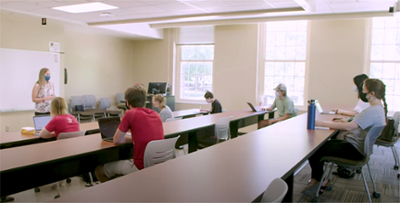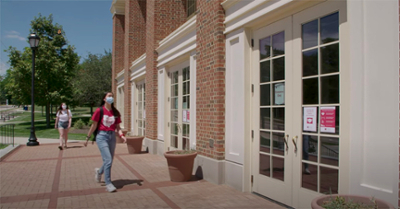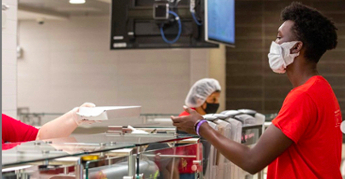
Five things to know as Miami students return to campus
Miami University will resume in-person and hybrid classes on campus beginning Monday, Sept. 21, as planned. Residential students will continue their phased move-in during the week of Sept. 14. Classes have been offered entirely online from Aug. 17-Sept. 20, and remote classes will continue for many students.
A phased move-in to residence halls
To promote physical distancing, students were assigned a move-in day and time. For most, move-in will occur Sept. 14-20.
“The on-campus student population will be significantly lower than previous years, as many students chose to pursue the fall semester remotely; therefore, the density of students living on-campus will be reduced by approximately 40%,” President Greg Crawford said in Wednesday’s message to the Miami community.
Preparations are in place

Students enter the Armstrong Student Center.
Miami is now in Phase 3 of the return to campus — opening residence halls and resuming in-person classes. Classrooms and work spaces have been modified to include safety precautions, such as plexiglass shields and increased distance between seating.
Supervisors of employees working remotely will inform them if they need to return to campus or continue working from home.
On Miami campuses, there is an emphasis on prevention: wearing face coverings, practicing social distancing of at least six feet, frequent hand washing and hand sanitization, complying with COVID-19 campus signage (directional, capacity, etc.) and cleaning up after oneself in common areas and classrooms. Cleaning products will be available throughout common spaces and classrooms.
When coming to campus, be sure to check your symptoms. For convenience, download the symptom tracking app, Campus Clear (available for download from the app store on your mobile device), which must be completed daily if coming to campus.
An illness/absence reporting system is also in place to help us track potential outbreaks in the community.
Mass gatherings of more than 10 people are prohibited, per the State of Ohio, City of Oxford ordinance and the Healthy Together Pledge. The Oxford Police Department sends student violations to Miami. Miami is charging these - and some other violations - as Endangering Public Health & Safety under the Code of Student Conduct. A typical sanction for this offense is suspension.
Serving students through a range of class options

Starting Sept. 21, Miami will offer in-person and hybrid classes in addition to remote learning.
Overall campus density will be significantly less than normal with nearly half of classes continuing to be delivered online/remotely and many employees continuing to work from home.
Provost Jason Osborne said in his message to the community Wednesday that faculty are to work with their department leadership and colleagues to make appropriate modifications to their course schedule as soon as possible, completing all changes ideally no later than Sept. 16.
Graduate student courses may continue as before, safely and on campus when needed, Osborne said.
Dining options available

A student picks up food at a dining location on campus.
Sanitation stations, physical distancing and enhanced safety protocols have been added, and there will be reduced seating capacity.
Remember that Miami transitioned to a cashless campus this summer. Miami IDs, virtual wallet, credit card and debit card payments will be accepted.
All staff will wear face coverings and gloves, with cashiers also wearing face shields.
Buffet locations will have staff-served service, based on the customer’s selections.
Food will be served in disposable containers. Seating will be limited and clearly marked for customers, or food can be taken to go.
Read this earlier news story for more information on what changes students will see this semester.
Testing is widespread and consistent
Miami will require students to be tested for COVID-19 upon arrival to campus, before moving into their residence halls. Testing is one component of Miami’s Healthy Together Plan.
The university launched a rigorous COVID-19 testing protocol in late August. In addition to diagnostic testing of students who are experiencing symptoms of COVID-19, the university also conducts wide-net and surveillance testing. This includes testing a random sampling of students who moved to the Oxford area as well as those who may have had contact with someone who tested positive for COVID-19.
Additionally, the university partnered closely with Butler County General Health District to track positive test results for every Miami University student tested – not just those who had a test in the university’s Student Health Center. Many other universities are only reporting cases that have come through their health centers. Miami believes this approach gives a more accurate and realistic picture of the impact of the virus on our campus community.
Learn more about testing, including the difference between wide-net and surveillance testing.
Compiled by Margo Kissell, university news and communications
